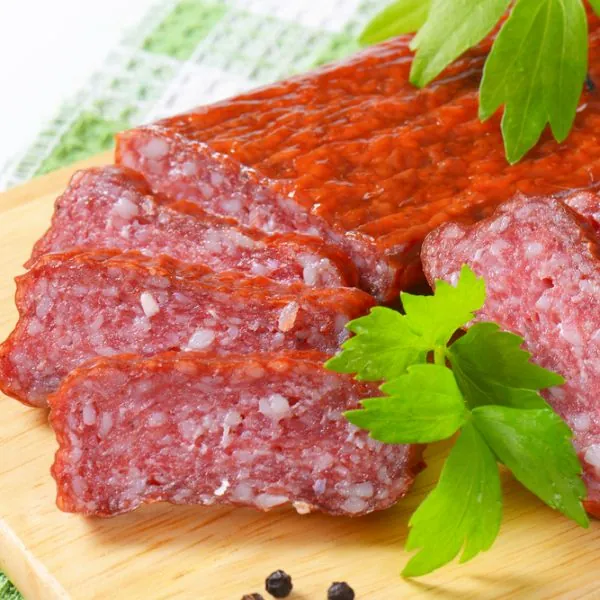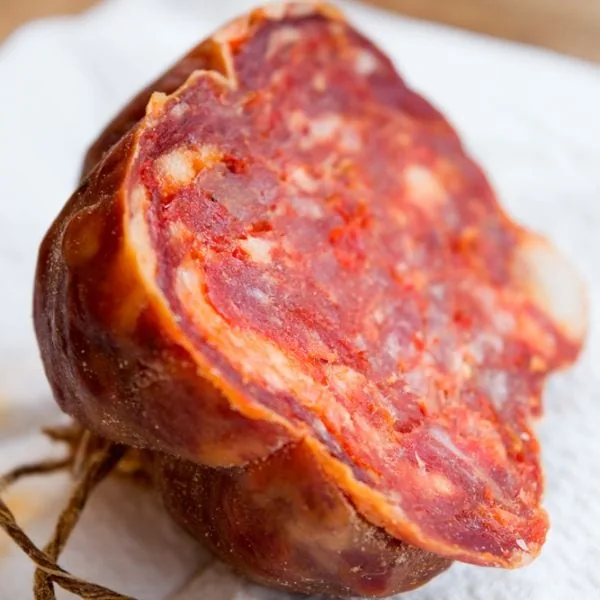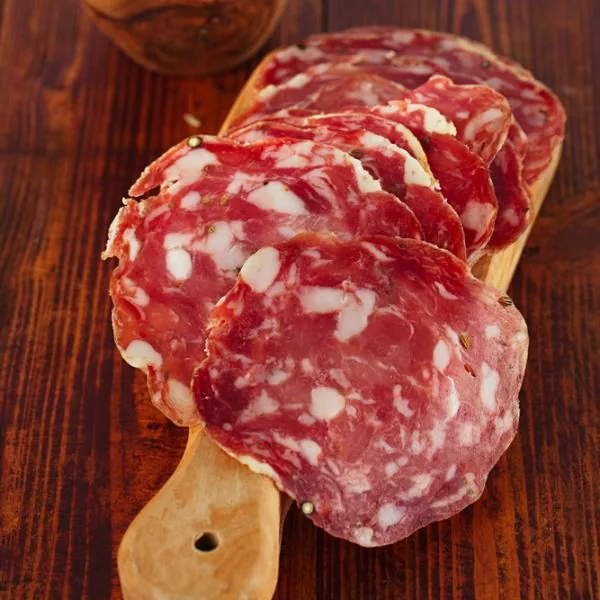Salami from your local deli and specially imported Italian salami is a real treat, but some of those specialty sausages can be a bit on the pricey side so it’s only natural to wonder… Just how long is a salami good for, anyways?
Well the good news, according to the USDA, is that the hard or dry salami varieties can last about 6 weeks just sitting in the pantry and almost indefinitely in your refrigerator – at least until you open it. Once you slice off some yummy salami, bacteria can get in and work mischief, at which point it will last for up to 3 weeks in the refrigerator or 2 months in the freezer.
There are quite a lot of types of salami, however, and so today we’re going to explore this topic in a little more detail. We’ll compare dried and fresh salami, explain what ‘salumi’ is, talk a little about how salami is actually made, and more!
If you’re curious about your favorite Italian deli meat, then read on as we give you the definitive answer to ‘how long is salami good for?’.
Dried, Hard, Uncured, and Fresh-Cooked Salami

To better determine how long your salami is going to last, you’ll need to know what kind of salami you are dealing with. Starting off we should say that Salami is just a cured sausage, which is usually air-dried and often fermented as a means of preservation and this is a clue to the name’s origins.
The root of ‘Salami’ is ‘sal’, which is the Latin word for salt!
While salami is traditionally made from pork, there are some types these days made from all kinds of different animals – ducks, venison, beef, lamb, and even horse and donkey salami! As there are so many types, we’re going to focus on some of the most common ones that you’ll run into and we’ll explain those first.
After that, we’ll give you a sampling of different salami types and also their estimated shelf life. Sadly, there are WAY TOO MANY different types of salami for us to cover them all, but once you know the basics then you’ll have a pretty good idea about salami shelf life.
What is dry salami?

When you hear the term ‘dry salami’, usually it’s referring to a type of Soppressata – a very popular type of salami that is made of a mix of fat cut and lean (or minced) pork which has been seasoned with black peppercorns, dried chiles, red wine, and salt. It is both fermented and dried, which helps to give this delicious salami some good resistance to bacteria.
The fermentation process often lasts about 48 to 72 hours and beneficial bacterial cultures are started to protect the meat and help provide some of the distinctive taste. It’s not uncommon, for instance, for a penicillin bacterial culture to be introduced through commercially-available mold spores.
There are other types of dry salami, though – it’s just USUALLY referring to Soppressata. Other types of dry salami include Nduja, pecorino cheese, and even Spanish chorizo (not to be confused with Mexican chorizo – more on that later).
What is hard salami?

Hard salami is a variation of Genoa salami, so let’s start with what Genoa is and explain the difference. Genoa is a salami typically made with pork, beef, or a combination of the two. It’s seasoned with peppercorns and like dry salami, helpful microorganisms are encouraged to make the meat safe for eating. With Genoa, the meat is placed in a damp container before the drying stage so that helpful bacterial cultures can permeate the meat as an early stage of preservation.
Hard salami differs in that it takes the Genoa model, and ‘gets fancy with it’. You’ll find extra, tasty ingredients such as:
- White peppercorns
- Garlic
- Fennel and other herbs
- Red or white wine
Hard salami usually has a similar, grainy texture, but it’s usually a lot drier than genoa and that makes it feel denser – thus the term ‘hard’ salami. It also lasts a little bit longer than Genoa as that extra drying makes a difference, but not long enough for you to treat them differently. Once you cut into either type, put what you don’t eat into the fridge and you’ve got weeks to eat the rest!
What is uncured salami?

‘Uncured’ salami is a little bit of a misleading term because it makes it sound like you’re dealing with meat that hasn’t been properly preserved. This is definitely NOT the case.
For the record, ‘uncured’ salami just means that it has been preserved with natural salts and flavors, instead of synthetic nitrates and nitrites. So, when you see uncured salami you can treat it the same way that you would the other dried and cured types – it’s still preserved, they’ve just gone the ‘natural’ route so it’s just as safe.
Somewhere along the way, ‘cured’ became associated with ‘nitrates and nitrites’, instead of just ‘salted’, and that’s when things got a bit confusing for consumers. You shouldn’t need to cook it in advance, just slice some off as you like and stick it in the fridge after you’ve eaten some — and start that ‘3-week timer’.
What about fresh-cooked salami?

There are fresh-cooked salami varieties that you’ll sometimes come across in the deli and it’s important to treat these types differently.
A good example is a Northern Italian favorite called Salame Cotto. This type of salami is made from pork which is mixed with salt and herbs and then slowly steamed to perfection.
This makes for a yummy salami, but don’t keep it in your fridge for longer than a week and if you are saving a few slices, 3 days is the absolute longest you should let them stay in the fridge. These soft, fresh salami varieties are simply not as hardy and resistant to bacteria as the heavily cured, dried, and fermented types.
Salumi, Salume, Salami – what’s the difference?
Before we go into some specific salami types and their shelf life, we wanted to quickly clarify some terms that you might hear in reference to salami and foods that seem like salami at first glance. To simplify things, when you hear ‘salumi’, ‘salume’, and ‘salami, here is what is meant:
- Salumi – In a nutshell, ‘salumi’ refers to the art of salting or otherwise preserving meat – most commonly pork meat. Most traditional salumi is made from 7 major pork muscles from a pig, with pancetta being the most popular example. Meats like salami, prosciutto, sopressata, fall under the category of ‘salumi’, which is why you hear that word sometimes thrown around the deli.
- Salume – ‘Salume’ is the singular form of ‘salumi’ and literally means ‘salted meat’.
- Salami – A sausage that has been salt-cured or cooked and which is often fermented.
To finalize the lesson we’ll add the last piece of the puzzle – Salumeria. ‘Salumeria’ is the word for an Italian cured meat shop or simply ‘an Italian deli’.
It seems a little confusing the first time that you hear these words, but they all sound similar because they are all deli shop terms, just in the original Italian!
Now that we’ve cleared up that part of the deli experience, let’s look at some different types of salamis and their shelf lives.
Five popular types of salami and their shelf-lives
To help demonstrate how close the shelf life is going to be for different types of salami, we’ve gathered a sampling of 5 of the most popular types and we’ll tell you a little about each and their shelf lives. Let’s take a look!
Cacciatore

Shelf life: Up to a year in the refrigerator, 2 years in the freezer, or 3 weeks once it’s been cut into.
Cacciatore salami is a small variety often referred to as ‘hunter’s style salami’, due to its portability and the minimalism that goes into spicing it – it’s more about tasting the meat itself than the extras. There might be a little garlic, sugar, and salt but those little extras are kept to a minimum.
As it’s still cured and dried, it lasts a long time until hunters and other cacciatore fans can make a hearty snack of it.
Spanish Chorizo

Shelf life: Whole sausages may be kept in the refrigerator for up to 2 weeks, but once opened they will stay fresh in the refrigerator for only 7 days.
Chorizo is considered a Spanish salami but we should note that it’s very different from Mexican chorizo. With Spanish chorizo, the meat is dried with garlic, paprika, and other herbs, while Mexican chorizo is made with fresh ground pork, herbs, and spices but sold RAW.
Calabrese

Shelf life: May be refrigerated almost indefinitely, although no more than a year is recommended. Once opened, it should last for up to 3 weeks in the refrigerator or 3- 5 days for individual slices.
Calabrese is a lovely southern Italian salami that is made from coarsely ground pork, seasoned with spicy red pepper flakes. This variety is typically dried for a week and then further cured for a period of 3 months, so it’s another very hardy type of salami that is made to last.
Finocchiona

Shelf life: Will stay for 6 weeks in the pantry, almost indefinitely in the refrigerator, but should be eaten within 3 weeks of cutting it open.
Finocchiona, a Tuscany salami, uses toasted fennel seeds instead of the traditional black peppercorns. As the story goes, peppercorns were expensive at the time, but fennel was delicious and abundant. The toasted seeds went in, along with garlic and salts, and the results were so delicious that they kept it!
As this salami is dried and cured, it’s robust like most salami and lasts a good, long time until it’s opened.
Pepperoni

Shelf life: 6 weeks in the pantry, almost forever in the refrigerator (but no more than 1 year is probably best), and it should be fully consumed within weeks of slicing it open.
Yes, you’ve read that right — Pepperoni is a type of salami (although that’s a one-way categorization. Salami is not a type of pepperoni) and this favorite has been wholeheartedly embraced in the United States and around the world.
Snacked on all by its lonesome or used as a pizza topping, this salami is both delicious and quite hardy – so you’ve got plenty of time to eat it if you can make yourself wait!
Understanding how real Italian salami is made

Getting a glimpse into the process of making Italian salami is probably the best way to understand how the meat is preserved so well. It’s quite the old tradition – the oldest Italian salami that we are aware of is the original Cacciatore, traced back to approximately 700 years ago in Tuscany.
While many traditional parts of the process are still kept, to give you the most accurate picture of what to expect from a modern salami, we’ll give you the steps with a few quick notes so that you have a better picture of what goes into today’s salami-making processes and how each step helps to keep the meat safe for storing and enjoying at your leisure.
At its most basic, this breaks down into 3 phases:
- Prepping the meat
- Packing with salt and other spices
- Fermenting and drying
We’ll tell you a little about each in the sections below so that you’ll have a proper understanding of how these delicious deli meats are transformed into the sausages we all know and love!
Prepping the meat
While many different types and cuts of meat are used for salami these days, pork is the most common and usually the meat is a blend of back fat and lean muscle that give salami its basic ‘signature flavors’.
The cuts of meat are selected, then chilled, and ground up depending on the type – for instance, Genoa is ground to a ‘medium’ consistency, while Calabrese is more of a ‘coarse’ grind.
Packing with salt and other spices
Now that the meat is nice and malleable, it’s time to add in the salt, herbs, and spices – with salt always being the first in line. Salt is our primary preservation method and it’s going to make that meat inhospitable for bacteria so that we can get it ready for further preservation techniques.
Once the proper ratio of salt to meat has been added to keep the salami from going bad, then spices may be added in – garlic, black pepper, fennel, and red pepper flakes. Sometimes wine is added at this phase and this provides some extra sugars that beneficial bacteria can use later in the fermentation phase.
Finally, if nitrites or nitrates are being added, then this is usually when it’s done – though most traditional salami makers scoff at adding the artificial preservatives since the curing, fermentation, and drying processes handed down over the ages have been preserving salami just fine for over 700 years now.
One difference in the modern day is that many salami makers will add a ‘starter culture’ of good bacteria at this time and during the fermentation phase. You can read a little more about it here if you like through the Gastrochemist – but we’ll keep things simple for now so that you’ve got just the basics that you can build on.
Once the meat is all mixed, it is stuffed into intestinal casings like any other sausage and it’s ready to ferment and dry.
Fermenting and drying
Fermentation is a useful thing – and it’s not just about feeling good on a Friday night.
Original beer recipes, for instance, didn’t have enough alcohol to get you intoxicated, but what they DID have was enough alcohol to make the river water safe to drink. Mankind discovered its wonders long ago and fermentation is a common phase of salami making that can help to keep bad bacteria from getting a foothold in the meat.
With salami, lactic acid fermentation is employed and this is what gives it part of its signature, tangy flavor.
It’s a carefully controlled process. Master salami makers (known as Salumieri) lower the temperature and ferment the meat for a few days, watching the pH level closely so that the bacteria is kept in check, without adding a ‘sour alcohol’ taste to the meat.
Another modern addition is that during this time, mold spores may be sprayed on the meat, such as the commercially available Bactoferm 600 that includes Penicillium cultures to stymy any bad bacteria further, although this is an optional step that the Salumieri decides on – they may just rely on the fermentation alone if they prefer a completely traditional salami.
After fermentation, it’s time to dry the meat, so that moisture from the center is drawn out via osmosis. This is also a slow, carefully-controlled process, as you have to remove large amounts of water to make sure that the meat is safe. The Salumieri does this by storing the drying meat in a chilly temperature of around 54 degrees Fahrenheit and the drying process is monitored and lasts around 4 weeks.
During this time, they’ll lose approximately 40% of their weight and become that distinctively-textured, dry, and hardened sausage that we all know so well.
Now you know why we’ve been avoiding the subject of freezing.
You technically CAN freeze salami, but now that you know what kind of transformation the meat goes through to get that specialized texture, it’s easier to understand why freezing is not really recommended. For one thing, you don’t really need it – if you haven’t opened the salami yet, simply sitting in the fridge will keep it fresh and tasty almost indefinitely, or at least until you open it.
In the freezer, as there is not much moisture content in the meat, the flavor may be maintained for some time – with Cacciatore, that would be around 2 years – but with freezers, there is a risk of affecting the carefully-cultivated texture of the meat so we don’t really recommend it.
There are just SO MANY different types of salami out there, with some being traditionally made, while others have quite a few modern and advanced steps — to the point that you shouldn’t freeze a salami unless you know full well how that one is made.
Mind you, it will PROBABLY be okay, but enough die-hard salami fans out there have raised a fuss on this subject that we tend to believe them – the extreme cold might well upset the careful alchemy of a master Salumieri and give you a sub-par salami and frankly, it’s not worth the risk!
How can I tell if salami has gone bad?
Knowing when salami has gone bad is important – it is meat, after all, and when meat goes bad then you want to identify that fast because it’s a serious peril. Here are some signs to look for if you’re wondering if something’s wrong with your salami:
- Ammonia is okay, but watch for other smells – Salami has a scent like ammonia and this is normal – When you first open it, you’ll definitely notice this, but that’s because beneficial bacteria has been cultured in it to keep the meat safe. It also smells a little acidic, often with a hint of cheese, and this is okay too. When you smell something like rotten eggs, however, then that means it’s gone bad. Don’t worry – you’ll get used to the usual scents quickly but it’s distinctly odd to your nose the first time you smell salami, especially if it’s warm.
- Fuzz – Salami has a white, powdery exterior and that’s the protective mold and the salami will have a consistent coloration on the outside and inside that you’ll get used to. When you see gray lines or any black, green, or brown fuzz, however, then this could mean it’s going bad and you’re looking at the ‘bad mold’. Keep an eye out for any new discoloration as it will be easy to spot and it’s a solid warning that the salami might be going bad.
- Texture changes – This is another one of those things you’ll get a feel for, but if you’re suddenly noticing a very different texture to a favorite salami, especially if it’s slimy, then you don’t want to eat it.
FAQs
That’s just about all of the time that we have for today but before we beat a hasty exit, we’ve got a few frequently asked questions for you to help ‘fill in the holes’ in our Salami 101 class for today. Let’s take a look and then we’ll wrap things up!
Why is lactic acid fermentation used in preserving salami?
Lactic acid fermentation is ideal for salami for two basic reasons. First, it helps to target coagulase-negative bacteria that might otherwise devour fatty and amino acids and start creating volatile compounds in the meat.
The lactic acid fermentation makes the meat ‘uninhabitable’ for these bacteria and it also gives the salami that signature red color in the process!
Which is better for you – cured or uncured salami?
This is actually a subject of contention but the bottom line is that we simply do not have enough lab studies to give you a definitive answer. Some salami fans say that uncured is healthier for you since it uses natural ingredients and no added nitrites to nitrates.
On the flip side, no ‘added’ nitrites or nitrates doesn’t mean that they won’t be present at all – celery powder can be one source of these and it’s perfectly natural. You can read an excellent article on the subject here but to be clear – we just don’t have enough data and anyone who tells you otherwise is probably trying to sell you their salami!
Can I vacuum seal salami to make it last forever?
Theoretically, you could, and it would likely make the salami last longer, but we don’t recommend it and we’ll tell you why. Salami is best considered a ‘live product’. You’ve got specifically cultured bacteria in there actively working to keep bas strains from getting at the meat.
The ideal storage for a salami that hasn’t been opened is a brown paper bag, at no higher than 18 degrees Celsius/64 degrees Fahrenheit, so that it continues curing over time. It was literally designed to be kept in the pantry way back before refrigerators were really a ‘thing’, so while you could certainly step things up and vacuum seal it, if you just store it the way it was intended to be stored it will keep hardening as it continues curing naturally over time.
In the refrigerator, in the simple, brown paper bag that you bought it in, it will last quite long enough to be there when you’re ready to enjoy it.
Wrapping up on the longevity of Salami
In today’s article we’ve answered the question ‘how long does salami last?’ and the quick answer is ‘6 weeks in the pantry and almost indefinitely in your refrigerator until you cut it open and then you’ve got about 3 weeks.
The more accurate answer is that this is a ‘living’ product with carefully-cultured strains of beneficial bacteria keeping it fresh and the type of salami is going to make some difference in the shelf life, although not by a huge amount – it’s pretty much all salted, fermented, and dried, with the occasional extra steps that vary from maker to maker.
We want to thank you for your visit today and if salami is an interest of yours or you make your own from time to time, then be sure to share some comments and get a dialogue going.
Salami has a rich and fascinating history, after all, so if you have some lore that you’d like to add to the subject, we can’t wait to hear it!





David learned to cook at an early age after his mother told him that he couldn't live on pizza forever, Dave uses his modest kitchen skills to recreate sorely-missed recipes from home and to occasionally make new favorite ones from places he is visiting.